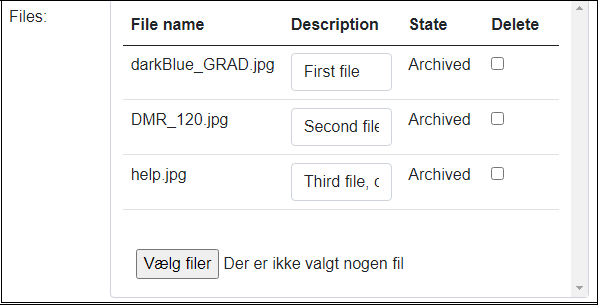The File Archive service handles everything needed to store and retrieve files from an archive.
It consist of a Blazor component for displaying and maintaining the content of the file archive. Further, it contains classes to support the Blazor visual component and maintaining the file archive programmatically.
In the File Archive, files are grouped by a ‘parent key’. What that key is, is up to you. It could be a incident report Id, an order number or something completely different.
The visual component can be configured to match the needs in the specific case.
The service has been developed in .NET 8.
Fully functional example project
This repo contains a project that is the actual components, it’s support classes and a demo project, where you can see examples of various configurations of the component:
- Allow users to add files to a the File Archive
- Allow users to see files already in the File Archive
- Allow users to enter/maintain a description of the files in the File Archive
- Allow users to delete files in the File Archive
- Only display files and allow download
The File Archive consist of two parts:
- Information about the files in the File Archive
- Storage of the actual files
The component project contains classes to store the information about files in either a JSON file (should only be used in these demos) or in a database using Entity Framework. Further, the project contains a class to store the files either in a folder on the harddrive or in Azure Blob Storage (or Azurite Blob Storage).
How does it work?
There are four parts that make the File Archive service:
- Method to read information about the files already in the File Archive
- Component to maintain the File Archive
- Method to store changes made to information about files and store the files themselfs
- Web API to download files
Internally when a user uploads files, the files are stored under an Id. The original filename is only stored as a part of the information about the file. This prohibit that users can try to do malicious things by giving files bad names.
Installation instructions
Getting and trying out the File Archive service
Download the repo and open the demo project in Visual Studio. The repo is set up to store information about files in a JSON file. This is only for demo purpose for a single user. It will not work in a multiuser environment. Further, the demo project is configured to store the actual files in the folder ‘C:\FileArchiveStorage’. You must create this folder before running the demo project. If the folder does not exist, an exception is thrown. Play around with the demo.
Please note, that the demo project is prepared for using Data First with Entity Framework, should you wish the store information on a SQL server.
Setting up your own project to use the File Archive service
To use the File Archive service in your own projects, you must add the service project to your solution. Then you must decide how files are to be stored. There are to classes for that. One that will store files in a folder on the harddrive, and one that will store the files in Azure Blob storage. Then you need to add a number of services to the Program.cs in your main project. Example from demo project:
The two services at bottom, are for the Java Web Token security that is used when downloading files.
Adding and using the File Archive component in your own projects
Add the File Archive component to the relevant pages in your project. If the page is an Update page, you must add code to retrieve information about the files in the archive (see demos). This list is passed to the File Archive component, in order for the user to maintain the File Archive.
In the method that handles a successful submit request (the OnValidSubmit property on the EditForm tag), you must call the method that will maintain the File Archive and possibly upload new files. Please take a closer look at the code in the demos and copy the necessary code over.
As files are to be stored under a ‘parent key’, your OnValidSubmit method must establish the parent key in create situations.
Please note that depending on the config of the File Archive component, the user can download the files in the archive.
Modifying the File Archive service for your own use
Allowing users to upload files opens a risk of virus infected files entering your system. You should definitely consider extending the upload part, have it call a virus scanner. Which method that is the right one for you, is something that you must figure out.
There are services that expose a virus scanner API that you can call. When using the option to store files on a folder, make sure that the virus scanner on the server scans the folder in question.
Your organisation can have other requirements that are not covered by my project. Please feel free to adapt a local version to fit your needs.
Remember to change the passphrase for the signing of the Java Web Token.

